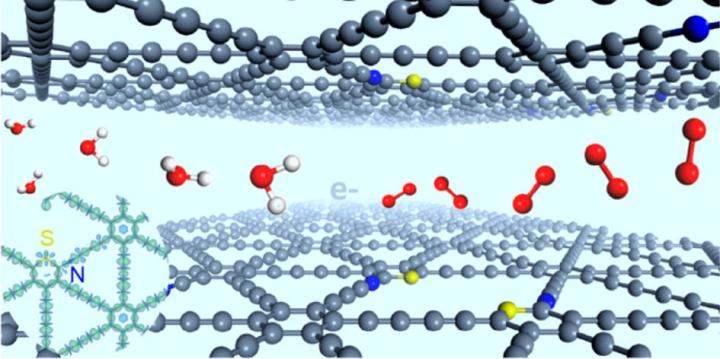Scientists develop stereodefined N and S atom-codoped graphdiyne for oxygen evolution

Stereodefined sp-N and S atoms for efficient oxygen evolution. Credit: ZHAO Yasong
Traditional OER catalysts, e.g. RuO2 and IrO2, are limited by high cost and declining stability. Heteroatom-doped carbon materials, especially dual doping, have displayed intriguing potential for highly efficient electrocatalysis owing to the synergistic effect.
However, the doping sites for different atoms are highly uncontrollable, which makes the structure-property study difficult.
The synergistic effect can only take place within a certain distance between the dual atoms, and 7.5 Å is the upper limit for N and S atoms to obtain a strong synergistic effect.
Scientists from the Institute of Process Engineering (IPE) of the Chinese Academy of Sciences successfully prepared “stereodefined” N and S atoms codoped graphdiyne, and the relative positions of the N and S atoms were well controlled.
“N-, S-codoped graphdiyne presented higher catalytic activity than those catalysts with individual-element doping (N or S atom) and commercial RuO2 in catalyzing the OER, possessing lower overpotential (299 mV) and higher current density (47.2 mA/cm2, 1.6 V), ” said WANG Dan, who led this research.
This study opens an avenue for understanding the synergistic effects in heteroelement-doped metal-free catalysts, and for further guiding the rational design and preparation of highly efficient catalysts for energy conversion and storage.
Media Contact
More Information:
http://dx.doi.org/10.1021/jacs.8b13695All latest news from the category: Life Sciences and Chemistry
Articles and reports from the Life Sciences and chemistry area deal with applied and basic research into modern biology, chemistry and human medicine.
Valuable information can be found on a range of life sciences fields including bacteriology, biochemistry, bionics, bioinformatics, biophysics, biotechnology, genetics, geobotany, human biology, marine biology, microbiology, molecular biology, cellular biology, zoology, bioinorganic chemistry, microchemistry and environmental chemistry.
Newest articles

Security vulnerability in browser interface
… allows computer access via graphics card. Researchers at Graz University of Technology were successful with three different side-channel attacks on graphics cards via the WebGPU browser interface. The attacks…

A closer look at mechanochemistry
Ferdi Schüth and his team at the Max Planck Institut für Kohlenforschung in Mülheim/Germany have been studying the phenomena of mechanochemistry for several years. But what actually happens at the…

Severe Vulnerabilities Discovered in Software to Protect Internet Routing
A research team from the National Research Center for Applied Cybersecurity ATHENE led by Prof. Dr. Haya Schulmann has uncovered 18 vulnerabilities in crucial software components of Resource Public Key…





















